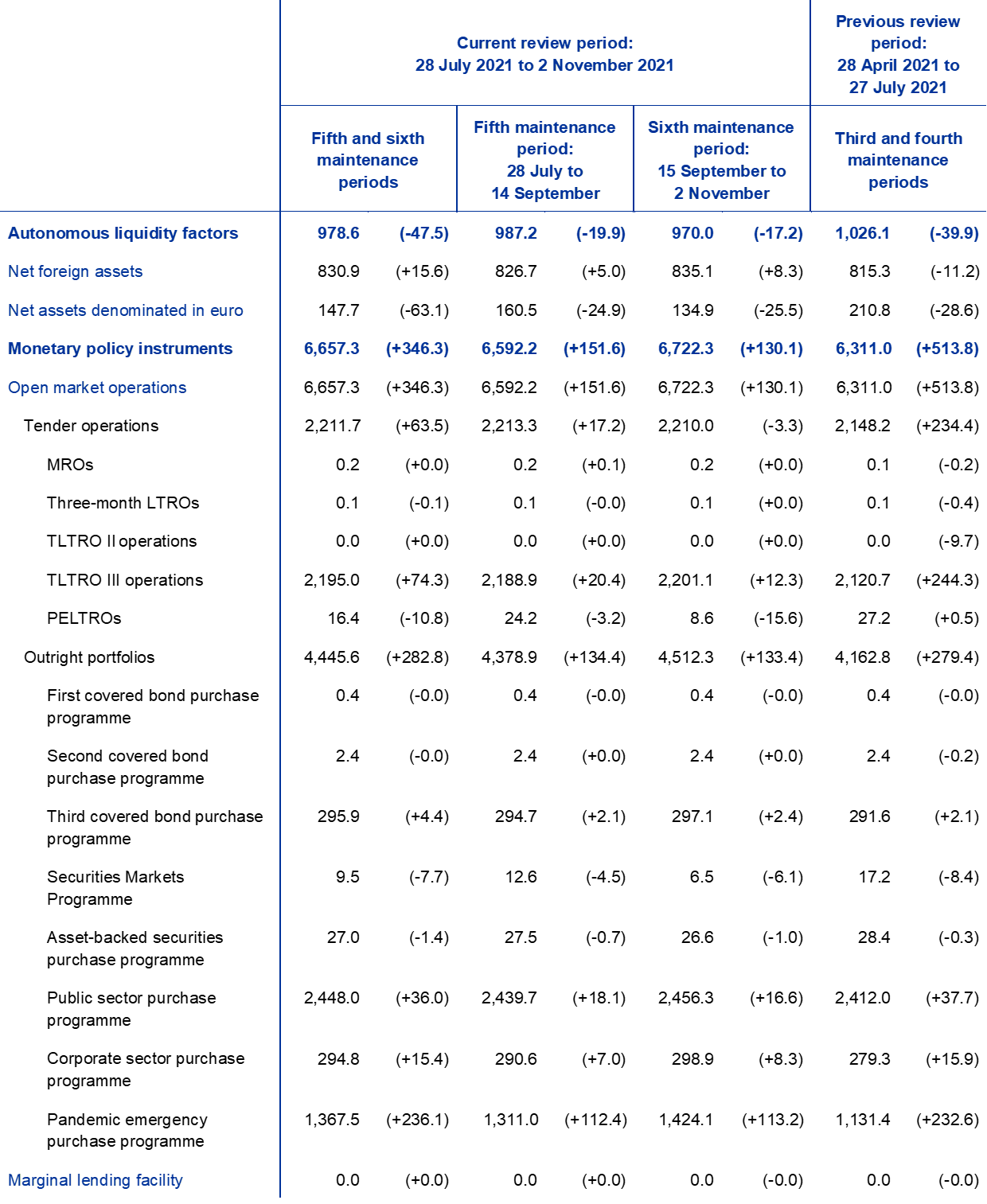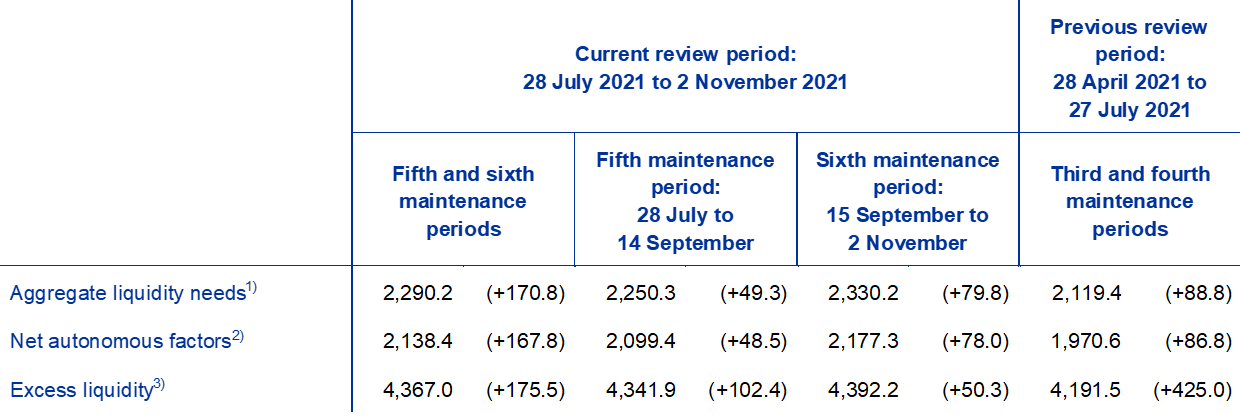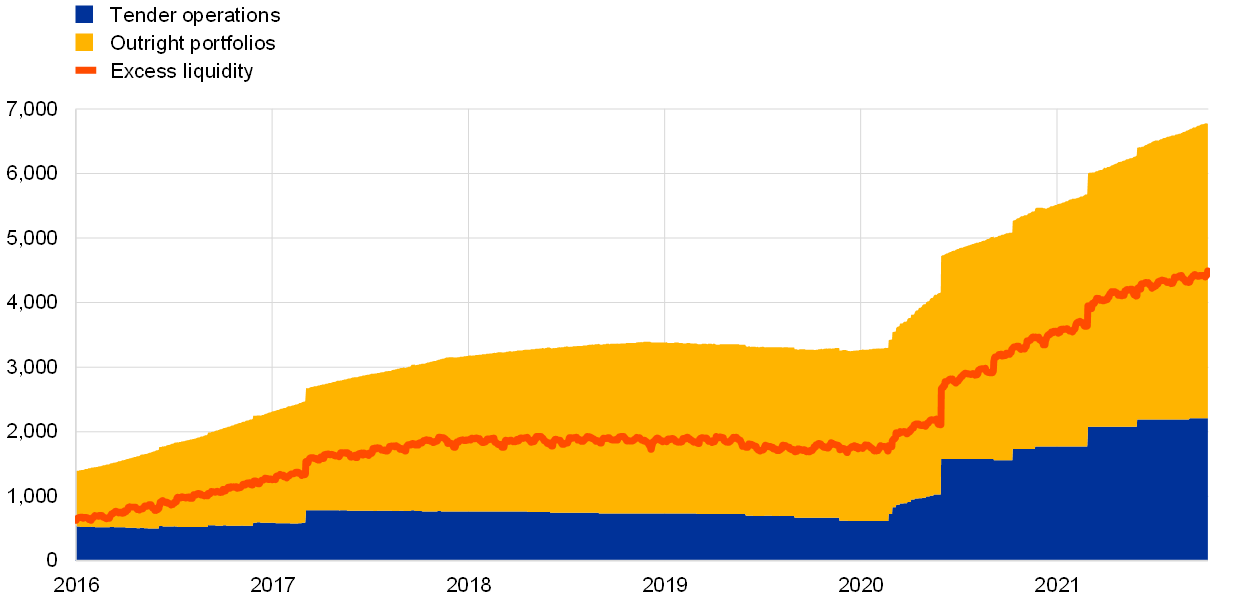Liquidity conditions and monetary policy operations from 28 July to 2 November 2021
Published as part of the ECB Economic Bulletin, Issue 8/2021.
This box describes the ECB’s monetary policy operations and liquidity developments during the fifth and sixth reserve maintenance periods of 2021. Together, these two maintenance periods ran from 28 July to 2 November 2021 (the “review period”).
Average excess liquidity in the euro area banking system rose by €175.5 billion during the fifth and sixth maintenance periods of 2021, reaching a record level of €4,367 billion. This was largely due to asset purchases conducted under the pandemic emergency purchase programme (PEPP) and the asset purchase programme (APP) as well as the settlement of the eighth and ninth operations of the third series of targeted longer-term refinancing operations (TLTRO III.8 and III.9). The effect of monetary policy operations on excess liquidity was partially offset by a sizeable increase in net autonomous factors.
Liquidity needs
The average daily liquidity needs of the banking system, defined as the sum of net autonomous factors and reserve requirements, increased by €170.8 billion to €2,290.2 billion in the review period. The significant increase compared to the previous two maintenance periods was almost totally due to an increase in net autonomous factors by €167.8 billion to €2,138.4 billion (see the section of Table A entitled “Other liquidity-based information”), while minimum reserve requirements increased only marginally by €3 billion to €151.9 billion.
Liquidity-absorbing autonomous factors in the review period increased by €120.3 billion to €3,116.6 billion, driven by other autonomous factors as well as increases in banknotes in circulation and government deposits. Other autonomous factors (see Table A below for further information) increased in the review period by €55.1 billion to €959.4 billion. At the same time, banknotes in circulation increased by €28.7 billion to €1,503.7 billion. Government deposits remain at a very high level after increasing by €36.6 billion to €653.5 billion, although this is below the record high of €729.8 billion reached in 2020.
Liquidity-providing autonomous factors decreased by €47.5 billion to €978.6 billion. This decrease was the net effect of a decline of €63.1 billion in net assets denominated in euro and an increase of €15.6 billion in net foreign assets.
Table A provides an overview of the autonomous factors[1] discussed above and their changes.
Table A
Eurosystem liquidity conditions
Liabilities
(averages; EUR billions)

Source: ECB.
Notes: All figures in the table are rounded to the nearest €0.1 billion. Figures in brackets denote the change from the previous review or maintenance period.
1) Computed as the sum of the revaluation accounts, other claims and liabilities of euro area residents, capital and reserves.
2) Memo item that does not appear on the Eurosystem balance sheet and therefore should not be included in the calculation of total liabilities.
3) Exempted and non-exempted excess reserves are explained on the ECB’s website.
Assets
(averages; EUR billions)

Source: ECB.
Notes: All figures in the table are rounded to the nearest €0.1 billion. Figures in brackets denote the change from the previous review or maintenance period.
Other liquidity-based information
(averages; EUR billions)

Source: ECB.
Notes: All figures in the table are rounded to the nearest €0.1 billion. Figures in brackets denote the change from the previous review or maintenance period.
1) Computed as the sum of net autonomous factors and minimum reserve requirements.
2) Computed as the difference between autonomous liquidity factors on the liability side and autonomous liquidity factors on the asset side. For the purposes of this table, items in the course of settlement are also added to net autonomous factors.
3) Computed as the sum of current accounts above minimum reserve requirements and the recourse to the deposit facility minus the recourse to the marginal lending facility.
Interest rate developments
(averages; percentages)

Source: ECB.
Notes: Figures in brackets denote the change from the previous review or maintenance period.
1) Computed as the euro short-term rate (€STR) plus 8.5 basis points since 1 October 2019. Differences in the changes shown for the euro overnight index average (EONIA) and the €STR are due to rounding.
Liquidity provided through monetary policy instruments
The average amount of liquidity provided through monetary policy instruments increased by €346.3 billion to €6,657.3 billion during the review period (Chart A). Around 82% of the increase was the result of ongoing net purchases under the asset purchase programmes, primarily the PEPP, and the remaining 18% originated from credit operations, particularly TLTRO III, while maturing operations and repayments drained liquidity.
Chart A
Evolution of liquidity provided through open market operations and excess liquidity
(EUR billions)

Source: ECB.
Note: The latest observation is for 2 November 2021.
The average amount of liquidity provided through credit operations increased by €63.5 billion during the review period. This increase was driven both by the effect of the €109.8 billion injected via the eighth TLTRO III operation settled in June (the full effect of which on period averages only materialises in the maintenance period after settlement) and by the €97.6 billion allotted in the ninth TLTRO III operation at the end of September. The liquidity providing effect of the ninth operation was partially offset by the first round of voluntary repayments under the TLTRO III programme, which totalled €79.3 billion in September. In addition, at the end of September three pandemic emergency longer-term refinancing operations (PELTROs) matured for an amount of €22.1 billion, while only €1.3 billion was allotted in the September PELTRO. Overall, the new PELTRO allotments and maturing tenders together resulted in an average net liquidity absorption of €10.8 billion compared to the previous review period. The main refinancing operations (MROs) and three-month longer-term refinancing operations (LTROs) continued to play a marginal role, with the average recourse to both of these regular refinancing operations staying at record low levels, as in the previous review period.
At the same time, outright portfolios increased by €282.8 billion to €4,445.6 billion, owing to net purchases under the PEPP and the APP. Average holdings in the PEPP increased by €236.1 billion to €1,367.5 billion when compared to the average of the previous review period. Purchases under the PEPP represented the largest increase across the ECB’s asset purchase programmes, followed by the public sector purchase programme (PSPP) and the corporate sector purchase programme (CSPP), with average increases of €36 billion to €2,448 billion and €15.4 billion to €294.8 billion, respectively. The maturing of securities held in non-active programmes reduced the size of outright portfolios by €7.7 billion.
Excess liquidity
Average excess liquidity increased by €175.5 billion, reaching a new record high of €4,367 billion (Chart A). Excess liquidity is the sum of banks’ reserves above the reserve requirement and the recourse to the deposit facility net of any recourse to the marginal lending facility. It reflects the difference between the total liquidity provided to the banking system and banks’ liquidity needs. Banks’ current account holdings in excess of minimum reserve requirements grew by €143.3 billion to €3,614.5 billion, while the average recourse to the deposit facility increased by €32.2 billion to €752.6 billion.
Excess reserves exempt from the negative deposit facility rate under the two-tier system[2] rose by €17.1 billion to €904.2 billion. Non-exempt excess liquidity, which includes the deposit facility, increased by €155.4 billion, reaching €3,462.1 billion. The aggregate utilisation rate of the maximum exemption allowance, i.e. the ratio of exempted reserves to the maximum exempted amount[3], which has remained above 98% since the third maintenance period of 2020, decreased marginally from 99.3% to 99.2%. The share of exempted excess reserves in total excess liquidity stood at 20.7%, compared to 21.2% in the previous review period.
Interest rate developments
The average €STR remained broadly unchanged at -56.9 basis points during the review period. As a consequence of the high level of excess liquidity, the €STR continues to be relatively inelastic, even to substantial fluctuations in liquidity. Since October 2019, the EONIA has been calculated as the €STR plus a fixed spread of 8.5 basis points. Therefore, it moved in lockstep with the €STR, and continued to do so until the discontinuation of the EONIA on 3 January 2022. Since 18 October 2021, as part of the transition to the €STR as the new benchmark rate, the EONIA is no longer used in new derivatives contracts cleared by central counterparties. The ECB policy rates – the rates on the deposit facility, MROs and the marginal lending facility – were left unchanged during the review period.
- For further details on autonomous factors, see the article entitled “The liquidity management of the ECB”, Monthly Bulletin, ECB, May 2002.
- More information about the two-tier system for remunerating excess reserve holdings is available on the ECB’s website.
- The maximum exempted amount is measured as the sum of the minimum reserves and the exemption allowance, which is equal to six times the minimum reserves amount.


